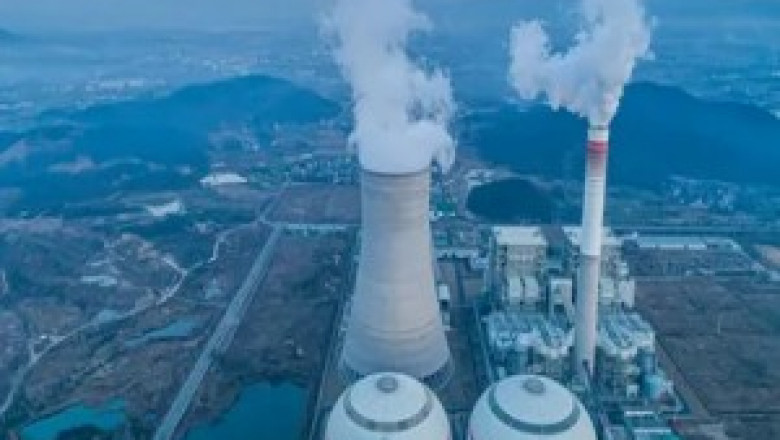views
How Does a Thorium Reactor Work?
A thorium reactor works differently than a traditional uranium reactor. In a thorium reactor, thorium-232 absorbs a neutron and transmutes into uranium-233. The uranium-233 then fissions, releasing more neutrons in a self-sustaining reaction. Unlike uranium-235, uranium-233 is fissile, meaning it can sustain a nuclear chain reaction on its own.
The key steps in the thorium fuel cycle are:
1. Thorium-232 absorbs a neutron to become thorium-233.
2. Thorium-233 decays into protactinium-233 with a half-life of 27 days.
3. Protactinium-233 decays into uranium-233 with a half-life of 27 days.
4. Uranium-233 is fissile and can sustain a nuclear chain reaction, releasing more neutrons and heat energy.
5. The neutrons go on to trigger more fissions, continuing the chain reaction within the reactor core.
Advantages of Thorium Over Uranium
Thorium Reactor has several advantages that make it very attractive for nuclear energy production:
- Abundance - Thorium is about three to four times more abundant in the Earth's crust than uranium. Identified thorium reserves could power humanity for thousands of years.
- Sustainability - Thorium breeder reactors can theoretically generate as much as 10 times more fuel than they consume. This makes thorium energy resources effectively renewable.
- Proliferation resistance - It is very difficult to convert the end products of thorium reactors, uranium-233 and other transuranics, into weapons. This reduces weapons proliferation risks.
- Less long-lived waste - The actinide waste from thorium reactors has much shorter half-lives ranging from a few years to a century rather than thousands of years. This eases the challenge of long-term geologic storage.
- Higher burnup - Thorium fuel can achieve a much higher fuel burnup factor than uranium, extracting more energy value from the fuel before it needs reprocessing.
Challenges of Thorium Reactors
While thorium energy holds great promise, developing practical thorium reactors also presents some challenges:
- Upfront research and development - Significant R&D is still needed to progress past the experimental and prototype stage to full-scale commercial thorium reactors. This requires substantial funding and long-term commitment.
- Fuel challenges - Thorium must first be converted to uranium-233 to become fissile, which requires detailed fuel cycle development and experience managing fissile material flows.
- Coolant technologies - Some molten salt or particle bed reactor designs proposed for thorium still need extensive engineering development to prove viability at scale.
- Regulatory acceptance - Nuclear regulators would need to license and oversee an entirely new fuel cycle and reactor technologies, which introduces regulatory complexity and delays.
- Supply chain establishment - New fuels, materials, and components suppliers would need to emerge to support a commercial thorium industry at scale.
Countries Advancing Thorium Research
Several countries are actively pursuing R&D programs focused on developing thorium reactor technologies:
- India - India has one of the most advanced thorium programs with their 300 MWe AHWR design in development. They hope to demonstrate a working prototype soon.
- China - China aims to demonstrate a molten salt thorium reactor within a decade and sees thorium as critical for energy security. Its CFR-600 test reactor will use thorium fuel.
- United States - Several US startups like TerraPower and ThorCon are developing molten salt reactor designs fueled by thorium to address waste and nonproliferation issues.
- Norway - The Norwegian ThorEnergy company aims to commercialize a high temperature pebble bed thorium reactor design by 2030 for industrial process heat.
- Russia - The Russian government supports research into the AST-500 Molten Salt Reactor concept that could burn mixed uranium-thorium fuel.
International collaboration on thorium will be crucial to fully exploring its potential for clean, abundant energy on a global scale in the decades ahead. Continued progress in countries pioneering thorium technology brings that future closer to reality.
About Author:
Priya Pandey is a dynamic and passionate editor with over three years of expertise in content editing and proofreading. Holding a bachelor's degree in biotechnology, Priya has a knack for making the content engaging. Her diverse portfolio includes editing documents across different industries, including food and beverages, information and technology, healthcare, chemical and materials, etc. Priya's meticulous attention to detail and commitment to excellence make her an invaluable asset in the world of content creation and refinement. (LinkedIn- https://www.linkedin.com/in/priya-pandey-8417a8173/)






















Comments
0 comment